How did the Barbarossa plan develop

In principle, that the campaign to the East will be, it was clear from the very beginning, Hitler was “programmed” to him. The question was different - when? 22 July 1940, F. Halder received a task from the commander of the ground forces to think about the various options for an operation against Russia. Initially, the plan was developed by General E. Marks, he enjoyed the special confidence of the Fuhrer, he proceeded from the general introduction received from Halder. 31 July 1940 at a meeting with the generals of the Wehrmacht Hitler told the general strategy of the operation: two main attacks, the first - in the southern strategic direction - to Kiev and Odessa, the second - in the northern strategic direction - through the Baltic States, to Moscow; further bilateral blow, from the north and south; later, an operation to seize the Caucasus, the oil fields of Baku.
On August 5, General E. Marx prepared an initial plan, "Plan Fritz". The main blow against him was from East Prussia and Northern Poland to Moscow. The main strike grouping, Army Group North, were to include 3 armies, a total of 68 divisions (of which 15 tank and 2 motorized). She was supposed to defeat the Red Army in the western direction, capture the northern part of European Russia and Moscow, then help the southern group in the capture of Ukraine. The second blow was delivered to Ukraine, Army Group South, consisting of 2 armies, a total of 35 divisions (including 5 tank and 6 motorized). Army Group South was supposed to defeat the Red Army troops in the south-western direction, capture Kiev and cross the Dnieper in the middle reaches. Both groups were supposed to reach the line: Arkhangelsk-Gorky-Rostov-on-Don. There were 44 divisions in reserve, they were to be concentrated in the offensive zone of the main strike group - "North". The main idea was in the "lightning war", the USSR was planned to be defeated in 9 weeks (!) In a favorable scenario and in the case of the worst in 17 weeks.
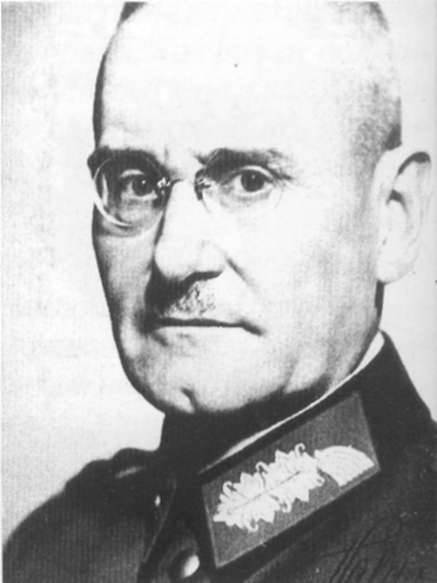
Franz Halder (1884-1972), 1939 photo
Weaknesses of the plan of E. Marx: the underestimation of the military power of the Red Army and the USSR as a whole; revaluation of their capabilities, i.e., the Wehrmacht; tolerances in a number of enemy retaliatory actions, thus, underestimated the capabilities of the military-political leadership in organizing defenses, counterstrikes, excessive hopes for the collapse of the state and political system, and the state's economy when rejecting the western regions. Opportunities to restore the economy and the army after the first defeats were excluded. The USSR confused 1918 with Russia, when, with the collapse of the front, small German troops along the railways were able to capture vast territories. A scenario was not developed in the event of a lightning-fast war developing into a protracted war. In short, the plan suffered adventurism bordering suicide. These errors were not eliminated and then.
Thus, German intelligence failed to properly assess the defense capability of the USSR, its military, economic, moral, political, and spiritual potentials. Gross mistakes were made in assessing the size of the Red Army, its mobilization potential, the quantitative and qualitative parameters of our air force and armored forces. Thus, according to Reich intelligence, in the USSR the annual production of aircraft in 1941 amounted to 3500-4000 aircraft, in reality, from 1 in January 1939 to 22 in June 1941, the Red Army received 17745 aircraft, including 3719 new designs.
In the captivity of the illusions of the "blitzkrieg" there were also the top military leaders of the Reich, so 17 in August 1940 of the year at the headquarters of the supreme commander Keitel called "a crime to create at present such production capacities that will have an effect only after 1941 of the year. You can only invest in such enterprises, which are necessary to achieve the goal and will have the corresponding effect. ”
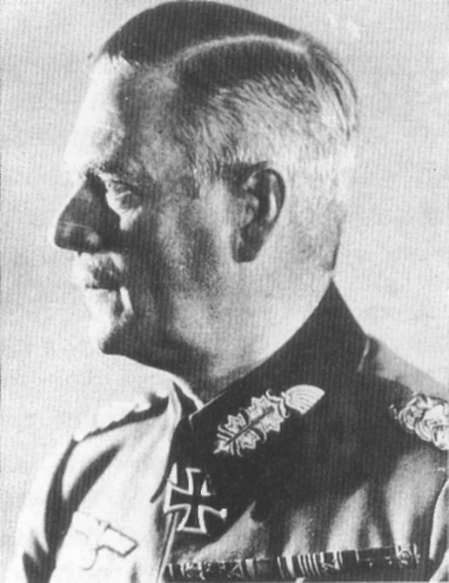
Wilhelm Keitel (1882-1946), 1939 photo
Further development
Further elaboration of the plan was entrusted to General F. Paulus, who received the post of assistant chief of staff of the land forces. In addition, Hitler joined the work of the generals, who were to become the chiefs of staff of army groups. They had to investigate the problem independently. By 17 September this work was completed and Paulus could summarize the results. 29 October, he provided a memorandum: "On the main plan of the operation against Russia." It emphasized that it was necessary to achieve a surprise strike, and to this end, develop and implement measures for disinformation of the enemy. It was indicated that it was necessary not to allow the Soviet border forces to retreat, surround and destroy them in the frontier zone.
At the same time, a plan of war was being developed at the headquarters of the operational leadership of the Supreme High Command. At the direction of Jodl, Lieutenant Colonel B. Lossberg was engaged in them. By September 15, he presented his plan of war, many of his ideas entered the final war plan: to destroy the main forces of the Red Army with lightning actions, preventing them from moving east, to cut off Western Russia from the Baltic and Black seas, to consolidate at such a line that would allow the most important areas of the European part of Russia, thus becoming a barrier against its Asian part. In this development, there are already three army groups: "North", "Center" and "South". Moreover, Army Group Center received most of the motorized and tank forces, beating Moscow, through Minsk and Smolensk. With the delay of the group "North", which beat in the direction of Leningrad, the troops of the "Center", after the capture of Smolensk, had to throw some of the forces to the northern direction. Army Group "South" was to break the enemy's troops, surrounding them, seize the Ukraine, force the Dnieper, on its northern flank, come into contact with the southern flank of the "Center" group. Finland and Romania were drawn into the war: a Finnish-German separate task force was to attack Leningrad, part of the forces in Murmansk. The final line of advance of the Wehrmacht. The fate of the Union had to decide whether there would be an internal catastrophe in it. Also, as in the plan of Paulus, much attention was paid to the suddenness of impact.
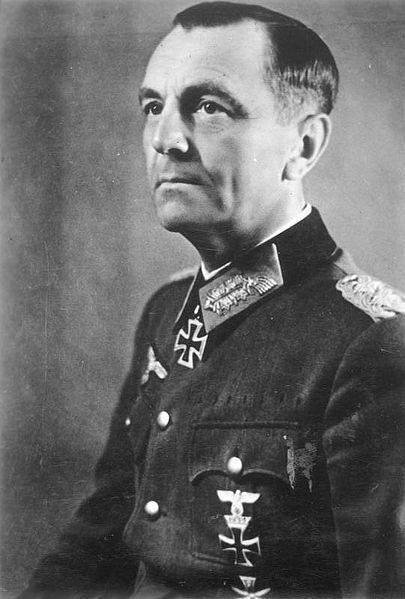
Friedrich Wilhelm Ernst Paulus (1890-1957).
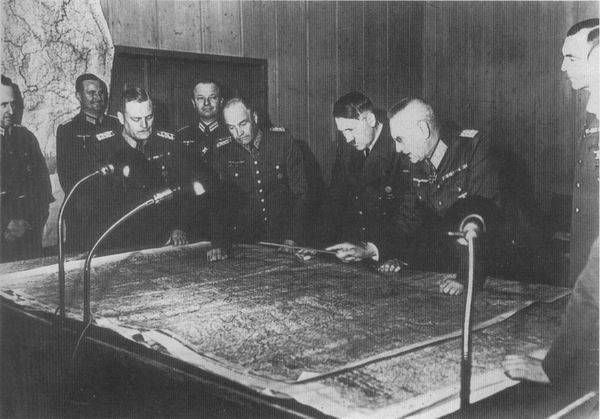
General Staff Meeting (1940). Meeting participants at the table with a map (from left to right): Wehrmacht Commander-in-Chief Field Marshal Keitel, Commander-in-Chief of the Ground Forces Colonel-General von Brauchitsch, Hitler, Chief of the General Staff Colonel-General Halder.
Plan "Otto"
Further development was continued, the plan was updated, on November 19 the plan, having received the code name "Otto", was reviewed by the ground forces commander Brauchitsch. He was approved without significant comments. 5 December 1940, the plan was presented to A. Hitler, the ultimate goal of the offensive of the three army groups were Arkhangelsk and Volga. Hitler approved it. From 29 November to 7 December 1940, the plan was held a war game.
18 December 1940, the year Hitler signed Directive No. XXUMX, the plan received the symbolic name "Barbarossa". Emperor Friedrich Redbeard was the pioneer of a series of campaigns to the East. For purposes of secrecy, the plan was made only in 21 copies. For secrecy, the armed forces of Romania, Hungary and Finland were supposed to receive specific tasks just before the start of the war. The preparations for the war were to be completed by 9 May 15.
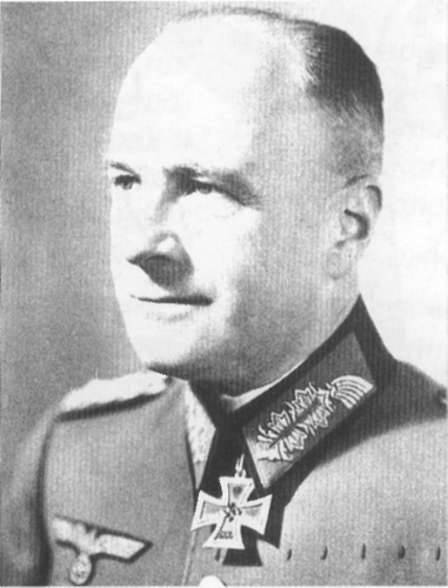
Walter von Brauchitsch (1881-1948), photo 1941
The essence of the plan "Barbarossa"
- The idea of a "lightning war" and a sudden strike. The ultimate goal for the Wehrmacht: line Arkhangelsk-Astrakhan.
- The maximum concentration of ground forces and air force. The destruction of the troops of the Red Army as a result of bold, deep and fast action tank "wedges". The Luftwaffe should have eliminated the possibility of effective actions by the Soviet air force at the very beginning of the operation.
- The Navy performed auxiliary tasks: support of the Wehrmacht from the sea; stopping the breakthrough of the Soviet Navy from the Baltic Sea; guarding your coast; to constrain with their actions the Soviet naval forces, ensuring navigation in the Baltic and supplying the northern flank of the Wehrmacht with sea.
- Strike in three strategic directions: northern - Baltic-Leningrad, central - Minsk-Smolensk-Moscow, southern - Kiev-Volga. The main blow went in the central direction.
In addition to Directive 21 No. 18 of December 1940, there were other documents: directives and directives on strategic concentration and deployment, logistics, disguise, disinformation, theater preparation, etc. 31 January, 1941 issued a directive OKH (General Staff of the Army) on the strategic concentration and deployment of troops, February 15 1941, the order of the Chief of Staff of the High Command to disguise was issued.
A. Hitler personally had a great influence on the plan, it was he who approved the offensive with 3 groups of armies, in order to capture the economically important regions of the USSR, he insisted on special attention - on the Baltic and Black Sea zones, including in the operational planning of the Urals and the Caucasus. He paid much attention to the southern strategic direction - the grain of Ukraine, the Donbass, the most important strategic importance of the Volga, and the oil of the Caucasus.
Impact forces, army groups, other groups
Huge forces were allocated for the strike: 190 divisions, including 153 German (including 33 tank and motorized), 37 infantry divisions of Finland, Romania, Hungary, two-thirds of the Reich Air Force, Navy forces, air forces and German allied naval forces. In the reserve of the High Command, Berlin left only the 24 divisions. And then in the west and southeast there were divisions with limited impact capabilities, designed to protect and ensure security. The only mobile reserve was two tank brigades in France, armed with captured tanks.
Army Group Center, commanded by F. Bock, delivered the main strike, consisting of two field armies — the 9th and 4th — two tank groups — the 3rd and 2nd — a total of 50 divisions and 2 brigades supported by 2nd air fleet. It was due to flank attacks (2 tank groups) to make a deep breakthrough south and north of Minsk, to surround a large group of Soviet forces, between Bialystok and Minsk. After the destruction of the encircled Soviet forces and reaching the border, Roslavl, Smolensk, Vitebsk considered two scenarios: first, if the Army Group North could not defeat the opposing forces, send tank groups against them, and the field armies should continue to move to Moscow; second, if the group "North" everything is going fine, by all means attack the Moscow.
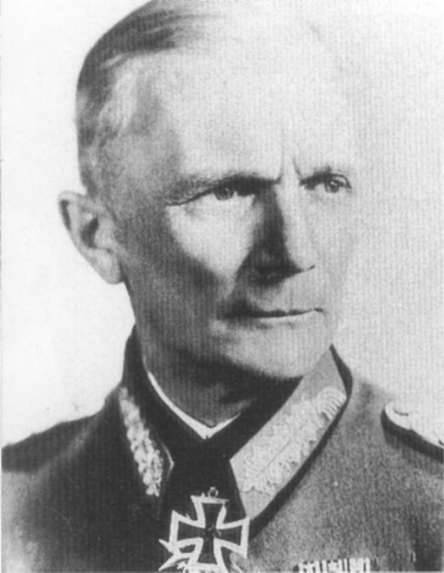
Fedor von Bock (1880-1945), photo 1940
Army Group North was commanded by Field Marshal Leeb, including the 16 and 18 field armies, the 4 tank group, all 29 divisions, supported by the 1 air fleet. She had to crush the forces opposing her, seize the Baltic ports, Leningrad, the bases of the Baltic Fleet. Then, together with the Finnish army and the German units transferred from Norway, they will break the resistance of the Soviet forces in the north of European Russia.
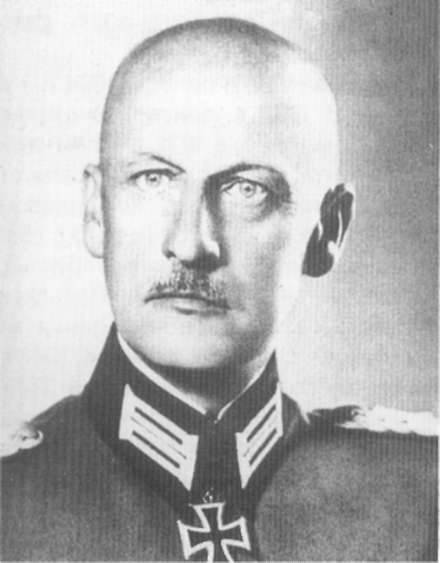
Wilhelm von Leeb (1876-1956), photo by 1940
Army Group "South", which beat south of the Pripyat marshes, commanded by Field Marshal G. Rndstedt. It consisted of: 6-I, 17-I, 11-I field armies, 1-I tank group, 3-I and 4-I Romanian armies, Hungarian mobile corps, with the support of 4-th Air Fleet of the Reich and the Romanian Air Force and Of Hungary. Total - 57 divisions and 13 brigades, of which 13 Romanian divisions, 9 Romanian and 4 Hungarian brigades. Rundstedt was to conduct an offensive on Kiev, smash the Red Army in Galicia, in the west of Ukraine, seize the crossings of the Dnieper, creating the prerequisites for further offensive actions. To do this, the 1-I tank group, in cooperation with the units of the 17 and 6 armies, had to break through the defenses in the area between Rawa-Rusa and Kovel, going through Berdichev and Zhytomyr, to go to the Dnieper near Kiev and south. Then strike along the Dnieper in the south-east direction in order to cut off the Red Army forces operating in Western Ukraine and destroy them. At this time, the 11 Army was supposed to create the visibility of the main attack from the territory of Romania by the Soviet leadership, holding down the forces of the Red Army and preventing them from leaving the Dniester.
The Romanian armies (the plan "Munich") were also to fetter the Soviet troops, to break through the defenses on the Tsutsora section, the New Bedrage.
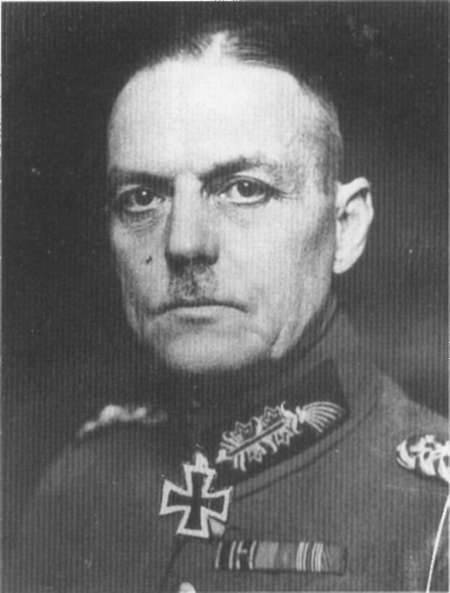
Karl Rudolf Gerd von Rundstedt (1875-1953), 1939 photo
In Finland and Norway, the German army "Norway" and two Finnish armies were concentrated, the entire 21 division and 3 brigades, with the support of the Reich 5 air fleet and the Finnish air force. Finnish units were to forge the Red Army in the Karelian and Petrozavodsk sectors. When the Army Group North entered the Luga River line, the Finns had to launch a decisive offensive on the Karelian Isthmus and between the Onega and Ladoga lakes, in order to connect with the Germans on the Svir River and the Leningrad region, they had to take part in the seizure of the second capital of the Union , the city must (or rather, this territory, the city was planned to be destroyed, and the population “disposed of”) to cross Finland. The German army "Norway" by the forces of two reinforced corps was to launch an attack on Murmansk and Kandalaksha. After the fall of Kandalaksha and the exit to the White Sea, the southern corps was to advance north along the railroad and, along with the north corps, capture Murmansk, Polar, destroying Soviet forces on the Kola Peninsula.
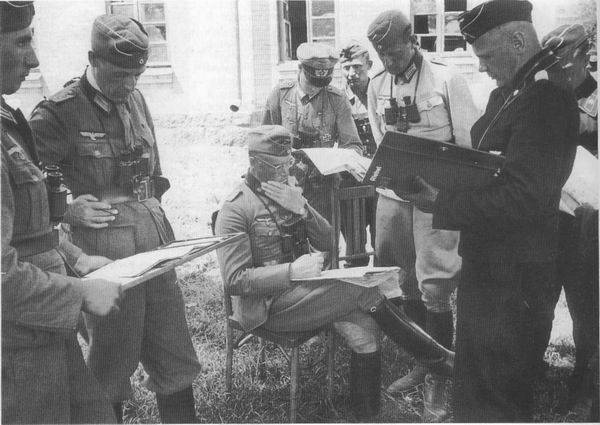
Discussion of the situation and the delivery of orders in one of the German units immediately before the attack of 22.06.1941.
The overall plan of Barbarossa, as well as the early developments, was adventurous and built on several “ifs”. If the USSR is a “colossus on clay legs”, if the Wehrmacht can do everything correctly and precisely in time, if it succeeds in destroying the main forces of the Red Army in the border “boilers”, if industry, the economy of the USSR cannot function normally after the loss of the western regions, especially Of Ukraine. The economy, the army, the allies were not prepared for a possible protracted war. There was no strategic plan in case of a blitzkrieg failure. As a result, when the blitzkrieg failed, I had to improvise.
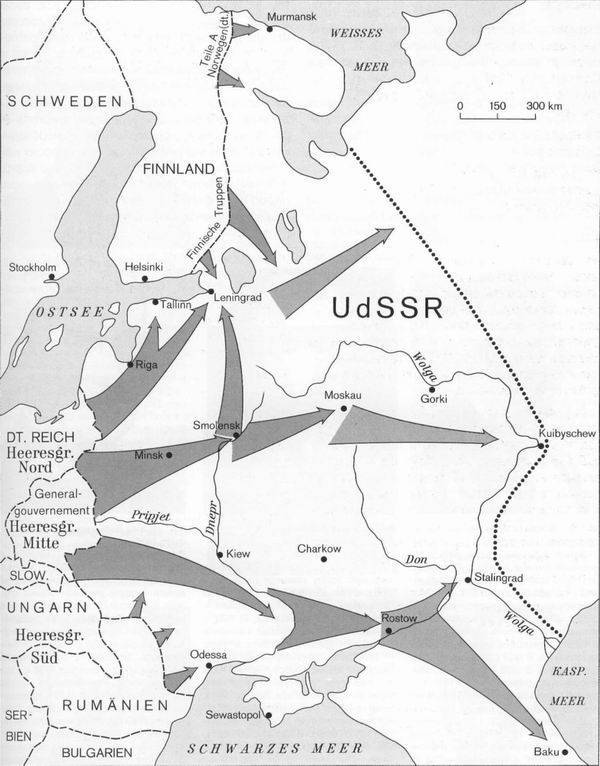
German Wehrmacht attack plan on Soviet Union, June 1941
Sources of:
The suddenness of an attack is a weapon of aggression. M., 2002.
The criminal goals of Nazi Germany in the war against the Soviet Union. Documents and materials. M., 1987.
http://www.gumer.info/bibliotek_Buks/History/Article/Pl_Barb.php
http://militera.lib.ru/db/halder/index.html
http://militera.lib.ru/memo/german/manstein/index.html
http://historic.ru/books/item/f00/s00/z0000019/index.shtml
http://katynbooks.narod.ru/foreign/dashichev-01.htm
http://protown.ru/information/hide/4979.html
http://www.warmech.ru/1941war/razrabotka_barbarossa.html
http://flot.com/publications/books/shelf/germanyvsussr/5.htm?print=Y
Information